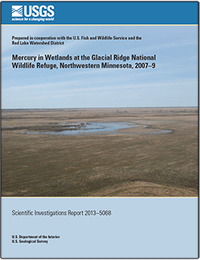The Glacial Ridge National Wildlife Refuge was established in 2004 on land in northwestern Minnesota that had previously undergone extensive wetland and prairie restorations. About 7,000 acres of drained wetlands were restored to their original hydrologic function and aquatic ecosystem. During 2007–9, the U.S. Geological Survey, in cooperation with the U.S. Fish and Wildlife Service and the Red Lake Watershed District, analyzed mercury concentrations in wetland water and sediment to evaluate the effect of wetland restoration on mercury methylation. The wetland waters sampled generally were of the calcium/magnesium bicarbonate type. Nitrogen in water was mostly in the form of dissolved-organic nitrogen, with very low dissolved-nitrate and dissolved-ammonia concentrations. About 71 percent of all phosphorus in water was dissolved, with one-half of that in the form of orthophosphorus. Wetland water had total-mercury and methylmercury concentrations ranging from 1.5 to 20 nanograms per liter (ng/L) and 0.2 to 16 ng/L, respectively. Median concentrations were 7.1 and 2.9 ng/L, respectively. About one-half of the mercury in wetland water samples was in the form of methylmercury, but this form ranged from 7 to 81 percent of each sample.
Compared to concentrations in stream sediment samples collected throughout the United States, Glacial Ridge National Wildlife Refuge wetland sediment samples contained typical total-mercury concentrations, but methylmercury concentrations were nearly twice as high. The maximum concentration measured in Glacial Ridge National Wildlife Refuge wetland water approached the highest published water methylmercury concentration in uncontaminated waters of which we are aware. However, the upper quartile of water methylmercury concentrations is similar to concentrations reported for some impoundments and wetlands in northwestern Minnesota and North Dakota. Methylmercury concentrations in sampled wetlands were much higher than those from typical lakes or flowing streams throughout the United States.
The high concentrations of methylmercury measured in sampled wetlands indicate the potential for substantial methylmercury concentrations in aquatic biota and wildlife that consume those biota. These wetlands also are a methylmercury source for downstream lakes and rivers. The high concentrations of methylmercury in water, its bioaccumulation potential, and its known toxicity in aquatic birds and food webs highlight a need to assess methylmercury in the biota within these ecosystems. Better understanding of factors that control methylmercury production concentrations within aquatic food webs in ecosystems of the Glacial Ridge National Wildlife Refuge would enable resource managers to better understand and manage risk to wildlife.


